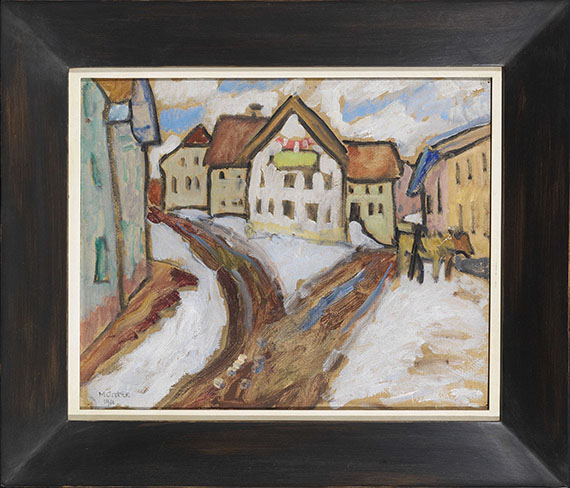117
Gabriele Münter
Tauwetter im Dorf (Murnau), 1911.
Oil on cardboard
Estimate:
€ 250,000 / $ 295,000 Sold:
€ 250,000 / $ 295,000 (incl. surcharge)
Tauwetter im Dorf (Murnau). 1911.
Oil on cardboard.
Signed and dated in lower left. Verso signed (partly covered up by an exhibition label) and titled, as well as with more hand-written inscriptions, such as "84". Verso with the estate stamp, an adhesive label and the stamped number "754", as well as with an adhesive label with the partly stamped number "L 193". 32.8 x 40.5 cm (12.9 x 15.9 in).
• Early Murnau townscape.
• Made in the founding year of the 'Blaue Reiter'.
• Radical and seminal structurization and simplification of the subject.
• On display at the galleries 'Emil Richter' and 'Der Sturm'.
• The work has not been showcased for more than 100 years.
Accompanied by a written confirmation from the Gabriele Münter - and Johannes Eichner-Foundation, Munich, from 17 October, 2019. The work will be included into the catalog raisonné of paintings by Gabriele Münter.
PROVENANCE: From the artist's estate (verso with the stamp).
Franz Resch, Gauting near Munich (council member of Münter foundation).
Private collection Rhineland (acquired from aforementioned in 1971).
Private collection Rhineland (inherited from aforementioned).
EXHIBITION: 11th exhibition of Der Sturm shown at: Opening Exhibition of Neuer Kunstsalon Max Dietzel, Munich, March - April 1913 cat. no.7 (title 'Tauwetter')
Kunstsalon Emil Richter, Dresden (verso with the label)
Gabriele Münter, 35th exhibition of Der Sturm, Berlin, opening on October 24, 1915, cat. no. 9 (verso with the label).
Oil on cardboard.
Signed and dated in lower left. Verso signed (partly covered up by an exhibition label) and titled, as well as with more hand-written inscriptions, such as "84". Verso with the estate stamp, an adhesive label and the stamped number "754", as well as with an adhesive label with the partly stamped number "L 193". 32.8 x 40.5 cm (12.9 x 15.9 in).
• Early Murnau townscape.
• Made in the founding year of the 'Blaue Reiter'.
• Radical and seminal structurization and simplification of the subject.
• On display at the galleries 'Emil Richter' and 'Der Sturm'.
• The work has not been showcased for more than 100 years.
Accompanied by a written confirmation from the Gabriele Münter - and Johannes Eichner-Foundation, Munich, from 17 October, 2019. The work will be included into the catalog raisonné of paintings by Gabriele Münter.
PROVENANCE: From the artist's estate (verso with the stamp).
Franz Resch, Gauting near Munich (council member of Münter foundation).
Private collection Rhineland (acquired from aforementioned in 1971).
Private collection Rhineland (inherited from aforementioned).
EXHIBITION: 11th exhibition of Der Sturm shown at: Opening Exhibition of Neuer Kunstsalon Max Dietzel, Munich, March - April 1913 cat. no.7 (title 'Tauwetter')
Kunstsalon Emil Richter, Dresden (verso with the label)
Gabriele Münter, 35th exhibition of Der Sturm, Berlin, opening on October 24, 1915, cat. no. 9 (verso with the label).
The intensity with which Gabriele Münter was occupied with methodical questions regarding her artistic creation is often overlooked. In 1910/11 the decisive question that came up was about the functions and the variability of the "form" in the picture. This question led to a radical and game-changing structurization and simplification of the subject of her pictures, which becomes particularly obvious in our work through the grid-like representation of the row of houses, as well as through the choice of motif itself: A road junction in Seehausen, a neighboring town of Murnau, leading through almost symmetrically fanned-out houses. Additionally, the year 1911 was also of great significance for Gabriele Münter’s private life. In this context "Tauwetter im Dorf" (Villa) can be interpreted as a programmatic statement that Gabriele Münter made. The "Neue Künstlervereinigung München" (Munich New Artist's Association), with Gabriele Münter and her companions as members, was founded two years earlier in 1909. After some time, however, tensions between more traditionally minded members and those with a progressive approach to art increased. As a consequence Kandinsky resigned from his post as chairman on January 10, 1911. Over the course of the year 1911 the idea of establishing an own artist group took shape: Kandinsky, Münter, Marc and Kubin founded the group "Der Blaue Reiter", which, next to the "Brücke", would become one of the most innovative and trend-setting movements in German art of the 20\up6 th century. Accordingly, at the beginning of 1911 artistic crossroads became manifest, and Gabriele Münter followed a path of renewal and modernization. In this sense the junction during a thaw can be understood as a reference to her very personal crossroads. [EH]
117
Gabriele Münter
Tauwetter im Dorf (Murnau), 1911.
Oil on cardboard
Estimate:
€ 250,000 / $ 295,000 Sold:
€ 250,000 / $ 295,000 (incl. surcharge)
Headquarters
Joseph-Wild-Str. 18
81829 Munich
Phone: +49 89 55 244-0
Fax: +49 89 55 244-177
info@kettererkunst.de
Louisa von Saucken / Undine Schleifer
Holstenwall 5
20355 Hamburg
Phone: +49 40 37 49 61-0
Fax: +49 40 37 49 61-66
infohamburg@kettererkunst.de
Dr. Simone Wiechers / Nane Schlage
Fasanenstr. 70
10719 Berlin
Phone: +49 30 88 67 53-63
Fax: +49 30 88 67 56-43
infoberlin@kettererkunst.de
Cordula Lichtenberg
Gertrudenstraße 24-28
50667 Cologne
Phone: +49 221 510 908-15
infokoeln@kettererkunst.de
Hessen
Rhineland-Palatinate
Miriam Heß
Phone: +49 62 21 58 80-038
Fax: +49 62 21 58 80-595
infoheidelberg@kettererkunst.de
We will inform you in time.




 Lot 117
Lot 117 

